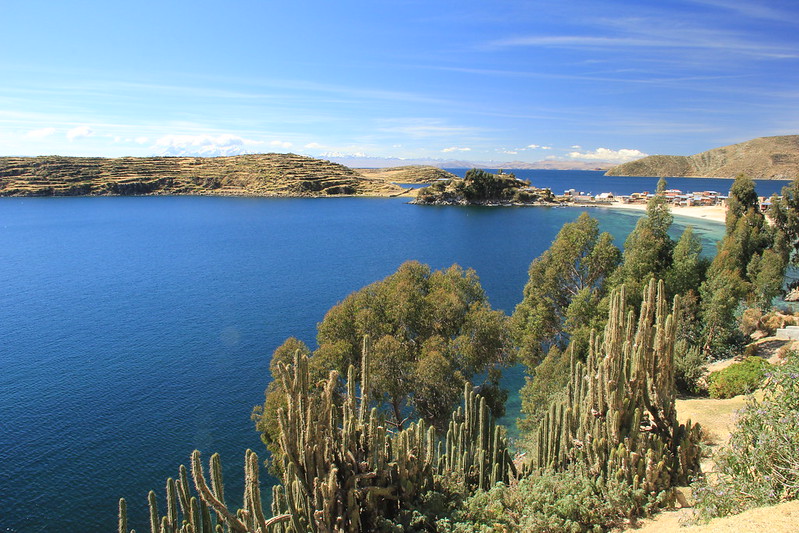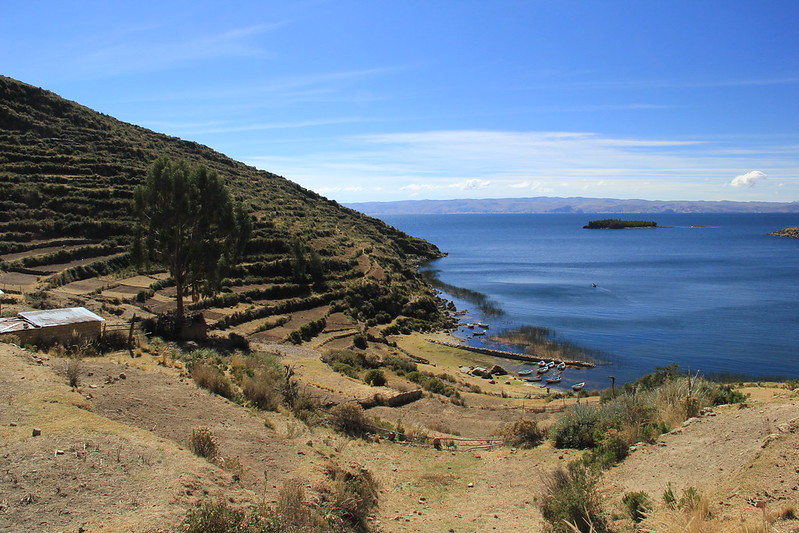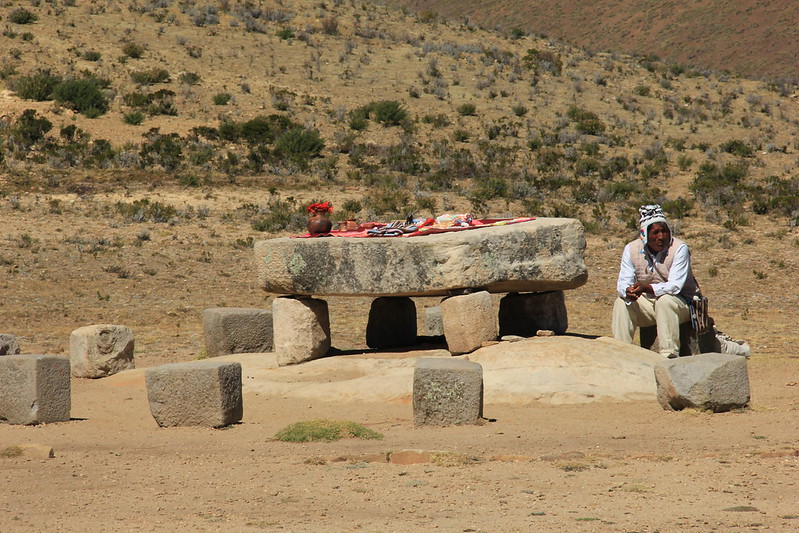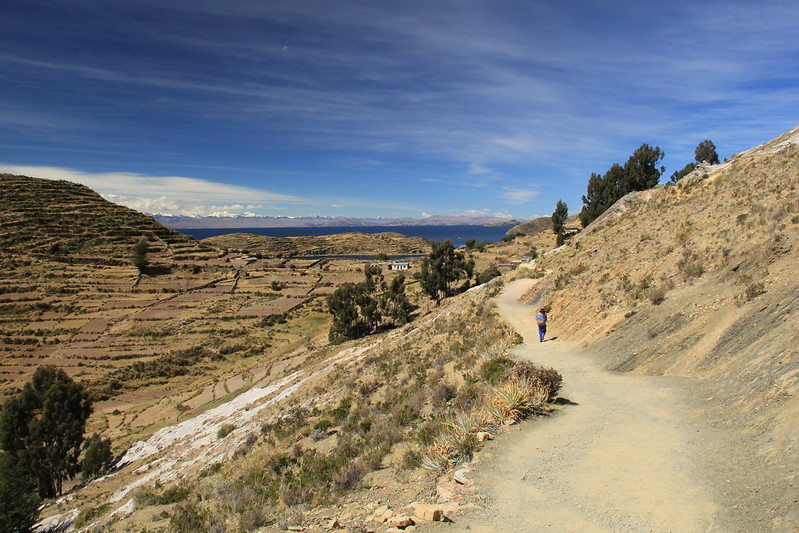In theory I wouldn’t have minded the prospect of being stranded the Isla del Sol, Bolivia – a picture-perfect island with incredible views, pre-Columbian ruins, and – as its name suggests – plentiful sunshine.
But when you only have the clothes on your back (which, whilst suited to the glorious sun-filled days, would have gone nowhere towards keeping us warm once the sun set) and the money in your pocket (which was enough to put food in our stomachs but not to provide a roof over our heads), this prospect suddenly seems much less appealing.
If you’d asked me what caused us to be potentially stranded, I’d say “time warp”. But as that answer requires a bit of an explanation, let me start from the beginning.
We couldn’t let our visit to Copacabana pass by without giving ourselves at least a day to explore the stunningly beautiful Isla del Sol, Bolivia. So we booked ourselves a couple of return tickets to the island with Andes Amazonia. The boat left Copacabana early in the morning, giving us a full day to explore the northern and southern ends of the Isla del Sol, which – according to the majority of articles we read beforehand – should have been ample time to take in all the major sights.
Isla del Sol is a rocky, hilly island whose terrain is harsh, with little vegetation cover. Despite its size (70 square kilometres) there are no motor vehicles or paved roads. But there are a lot of ruins, dating back to the 15th century – the most significant of which are Titi Qala, Chinkana, Q’asa Pata and Pillkukayna. The island of the sun is also important historically and religiously, because the Incas believe that it’s the birthplace of their revered Sun God.
We’d read that the island has a good tourist infrastructure, so when we arrived ashore we assumed that the trails to all the major tourist sites would be well-marked. Not so much. There were several pathways forking off from the main port, and having only the following map as reference, we were not 100% sure which one we should be taking.
With a limited amount of time on the island we could not afford to make any mistakes regarding directions. We had to be back at the port by 1:30pm in order to catch the boat down to the southern end of the island. If we made the journey on foot it would take 2-3 hours out of our day.
So we joined the small crowd that was beginning to gather around a local gentleman who we correctly identified as a tour guide. Despite the communication barriers (we wrongly assumed that, being a tour guide, he would speak and understand a basic level of English), we managed to obtain confirmation that – should we choose to join the tour – we’d have ample time to make it back to the port for the 1:30pm departure.
So we followed our guide as he led us across a small sandy beach and along a rocky pathway that hugged the edge of the island.
Enormous cactus plants overhung the rich blue waters of Lake Titicaca and pigs basked on the muddy shores. We passed tiny settlements, agricultural terraces, grazing animals, and numerous fishing boats moored upon marshland at the edge of the lake.
The landscapes were truly spectacular, and I couldn’t stop snapping photograph after photograph of those rugged vistas and that incredible cloud-brushed sky.
I only wish that I could have understood more of our guide’s commentary in order to gain a better understanding of the island and its people beyond the simple aesthetics. So many other travellers we met on our three-month journey around Peru had an infinitely superior grasp of the Spanish language compared to us (Australians Cameron and Cassie were able to translate entire paragraphs of information on our Lima walking tour) that I was starting to feel incredibly disheartened.
Would I ever be capable of understanding more than the odd word or sentence in Spanish? Would I ever get beyond the level of just about managing to get by? At this stage it certainly didn’t feel like it. Maybe I’m just not cut-out for languages after all.
Drifting off into my own thoughts whilst our guide was talking probably wasn’t going to help my cause.
We continued uphill.
We eventually reached a clearing in which our guide pointed out Titi Qala (Rock of the Puma), whose shape – if viewed from the southeast – apparently resembles a crouching Puma. Like the dead woman of the Inca Trail‘s Dead Woman’s Pass, I couldn’t see it, but then I was never any good at those Magic Eye pictures either…
According to tradition it’s here at Titi Qala that the sun first made its appearance, and for that reason this rock is regarded as a sacred landmark on the island.
Also in the clearing is a large stone table, supposedly once used for human sacrifices, and now adopted by locals as an object upon which to display their handicrafts, for sale to passing tourists.
A little further along the trail we reached Chinkana, the island’s most spectacular ruins complex. The main feature of the complex is the Palacio del Inca – or El Laberinto (The Labyrinth), to give it its Aymará name.
As its name suggests, El Laberinto is a maze of stone walls and tiny doorways, and at its core is a small well that the Inca’s believed contained sacred water. We took it in turns to fill our plastic bottles up with sacred water from the well. If it didn’t purify us, well at least it would keep us hydrated.
From above the terraced walls of the Chinkana complex there were some incredible views down on to Lake Titicaca, of hidden coves, deserted beaches, and (at the right time of year) the snow-capped peaks of Cordillera Real as a fitting backdrop.
It was 11:30am when our guide announced the end of the tour, so we decided to linger for an extra half an hour to soak up some more of those incredible views, before making our way back down to the port. If we left at midday we’d have an hour and a half to make a journey that had only taken us an hour on the way up.
Bearing in mind that we stopped on several occasions during our ascent, so that our guide could impart some of his local knowledge and information about the various points of interest at which we’d arrived, this gave us plenty of time (or so we thought) to make the descent.
In hindsight we considered that we probably needn’t have paid for a guide in the first place. We’d understood very little of his entirely Spanish commentary of the island’s attractions, and once we’d crossed the beach at the outset it was impossible not to end up at the northern tip of the island and the ruins of Chinkana.
So, at precisely midday we turned around and started to retrace our steps.
Aside from snapping a few photographs on our way down, we didn’t stop, we didn’t make any diversions, or take any forks (there were none), or indeed pass anyone with whom to share conversation.
Yet when we checked the time just as we approached the beach, that horrible moment of panic and disbelief suddenly overcame us as those numbers stared back at us – 13:50.
It couldn’t possibly be. There was no way we’d been walking for nearly two hours; the entire journey (with stops) had only taken us an hour on the way up. We strained our eyes in the bright sunlight, attempting to shade the screens on our mobile phones (neither of us had watches).
Surely it must be 13:20, but even that would be pushing it. It should only be around 12:50. That’s it, it must be 12:50. Twos can easily be mistaken for threes on a reflective screen that’s difficult to read.
We quickened our pace.
In hindsight I’m not entirely sure why. If it was in fact 13:50, then the boat had left 20 minutes ago; quickening our pace was not going to make time go backwards no matter how fast we walked. On the other hand if it was 12:50 then we’d arrive at the port in around 10 minutes if we continued at our standard walking pace; hurrying would mean we’d just have more time to kill at the port.
But panic had set in.
As we arrived at the port, we could see no Andes Amazonia boat and no potential passengers waiting for said boat. We desperately searched for some shade from where we could properly view the exact time of day.
14:02.
But how?
We’d checked the time at Chinkana both at the end of the tour and again before we set of in the direction of the port. How could we be wrong on BOTH occasions?
Nothing made sense. We seemed to have lost an hour of time, and could not explain how or why it had happened.
Assuming we weren’t about to enter another time warp that would take us back in time by an hour, we needed to find a way to get to the port on the southern tip of the island for 4pm. This was the time at which the last boat back to Copacabana left the Isla del Sol. This meant we had just under two hours.
According to our guidebook, it took 2-3 hours to make the trip on foot. Assuming that we power-walked the whole way, took the most direct route and didn’t make a single wrong turn or stop to map read or ask a local for directions, we MAY have been able to make it. But that was a big may, and it was a risk we couldn’t afford to take.
Staying overnight on the Isla del Sol was also not an option we were suitably equipped to consider, for reasons I explained earlier in this post.
So this left us with one viable alternative – find a man (or woman) with a boat.
We were close to one of the main settlements on an island with 2500 inhabitants, and considering that fishing is one of the major economic activities on the Isla del Sol (alongside farming and tourism), we assumed that this would not be a difficult task.
There were plenty of small boats moored up along the lakeside, but these boats were of no use to us whatsoever without someone to pilot one of them. The port was like a ghost town.
We wandered up and down the bay several times, each time our panic growing as we became very aware that the possibility of us being stranded was turning into a very real probability with every second that ticked past.
We started to count what little money we had between us, and considered whether we would have enough to pay for a basic room in a local hospedaje, some food for us both that evening AND two boat fares back to Copacabana (our return ticket we’d bought from Andes Amazonia the day before was only valid for today). Maybe our hosts would be kind enough to loan us a couple of extra blankets to wear down to the local market or restaurant.
Including all our small change we had approximately 230 Bolivianos altogether – that’s just £20.94.
We were about to head inland in search of some possible accommodation options when we caught sight of a local man walking down towards the port carrying a tree on his shoulder.
“Señor!”
“Discúlpe!”
A couple of panic-stricken gringos clearly wasn’t what he was expecting to find whilst going about his arboreal activities, for he appeared rather perturbed by the interruption.
Clumsily managing to string a sentence together using my very limited Spanish vocabulary I explained that we needed to get to the south of the island urgently, and asked if he could help.
As luck would have it, the boat that he was walking in the general direction of, was his.
We breathed what would we soon realised what be a all-too-short sigh of relief, as we enquired about the price.
“Doscientos cincuenta”
he responded.
250.
We only had 230.
But all was not lost. Bolivia is a country where haggling is an acceptable means of completing monetary transactions.
The only problem was that on this occasion we could not afford to walk away in the hope that our final offer may be accepted; this gentleman and his boat were our only chance of making it to Yumani by 4 p.m.
I offered 200.
Ok, so the difference of 50 bolivianos is only equivalent to £4.51 – not the best haggling I’ve ever done. But like I said, we couldn’t afford to piss this guy off; he was our only hope.
He looked down at the ground, shook his head, and began walking away from us.
“Señor! Señor!”
I called, chasing after him as I fumbled for my wallet.
When I had his attention, I pulled out 200 bolivianos in notes, and then emptied approximately 30 Bolivianos into my free hand, protesting desperately that that’s all we had, and pleading with him to take us.
His face was expressionless, but he nodded and indicated that we follow him in the direction of the boat.
Although we felt like we’d just parted with the earth to save our backs, I had to keep reminding myself that 230 bolivianos is only £20.74. We’d paid just £20 to charter our own private boat in order to make the 40-minute journey down to the southern tip of the island.
Whilst the original plan was to have almost an hour and a half in which to explore Pillkukayna and the village of Cha’lla on the southern end of Isla del Sol, we actually only had enough time to get off one boat, hop on to another, and stroke a donkey quickly in between.
But the main triumph was that I was able to add the word “almost” to the title of this post 😉
Visiting Isla del Sol, Bolivia |Practical Info
- If you do want to make the day trip to Isla del Sol, Bolivia, a return ticket from Copacabana with Andes Amazonia (located at the bottom end of 6 de Agosto) will cost you 40 bolivianos
- The boat leaves at 8am and the journey takes about an hour and a half.
- It’s relatively easy to find a guide at the port but if you don’t have a reasonable understanding of the Spanish language, we didn’t feel it was necessary. We paid 30 bolivianos each for our guide. We also paid 10 bolivianos to see the sights on the north of the island.
- The only boat that travels between the port at Cha’llapampa and the southern tip of the island each day, leaves at 1:30pm. Take a watch, or an alarm clock – or several alarm clocks to ensure that you know what the time is at all times.
- The last boat to leave the port at the southern tip of the island, to make the return journey to Copacabana leaves at 4pm, but get there early if you want to be guaranteed a seat.
My advice
If you’re planning to visit the Isla del Sol, Bolivia, my advice would be to stay overnight. A day is just not long enough to fully explore and appreciate the beauty of this island. Sleeping on the island also means that you’ll get to see some amazing sunrises and sunsets, and at night you can gaze up at a perfectly clear sky filled with an endless expanse of stars.
Visiting Isla del Sol, Bolivia | Where to Stay
There are 23 properties listed on booking.com for Isla del Sol, Bolivia, so my advice would be to head there first of all and see what’s available. Personally I love the look of this Isla del Sol Ecolodge.
Have you ever been stranded somewhere due to poor time keeping, bad organisation, unexplainable events, or time-warps? 😉

































10 Comments
Wow gorgeous photos! We made it to Copa but didn’t have time for Isla del Sol- seeing your photos of it is making me even more sad we missed it!
Aw, gutted…the only reason I visited Copacabana was because it was the jumping off point for the Isla del Sol. I didn’t really think much of Copa itself, apart from the Cerro Calvario viewpoint. There’s always going to be places we miss though, no matter how much time we have. I spent three months in Peru (and around half that in Bolivia) and still feel like I only just scratched the surface!
Wow, what a story! Did you ever figure out how you managed to lose an hour?? The island looks absolutely gorgeous though. The water is so incredibly blue and I love the picture with the little boats. I hate those situations where you’re tight on money! We definitely learned to make sure we always have more than enough if we’re going out of town for a day or two!
No, to this day I have never figured out what happened with that lost hour! It was an absolutely stunning little island though and had I known beforehand just how beautiful it was, I would have scheduled an overnight stay there for sure 🙂
Thanks Kiara for all the information! I’m just back from Isla del Sol, I followed your advice and stayed overnight. It was a good decision!
On arrival to the north part I also followed a guide who told us the tour would take 50min. But actually, my tour and most of the other tours lasted 2h, we finished at 12:30! Maybe that is where you lost one hour?
So pleased you made it there and loved it! Can’t wait to read all about your experiences 🙂
Oh gosh – this was so intense!! I was hooked by every word! So glad you managed to make it off the island and were able to put “almost” in the title of this post. What an adventure! Do you think you ended up taking a different route when you came back down? I don’t understand how an hour literally just disappeared from your day… so strange, timewarp is the only likely possibility!
So pleased you liked it! It’s one of my favourite posts 🙂 and in answer to your question, I honestly don’t know what happened. It’s unlikely we took a different route, because there was only one track to follow. The only conclusion I can come to is that we must have misread the time at the end of the tour. But that would also mean we misread the time when we left to make our way back. Still doesn’t make sense even now!
Did you maybe ever considered your phones switched to Peruvian time? It can happen on the island! 😉
I hadn’t, but that might actually explain it!